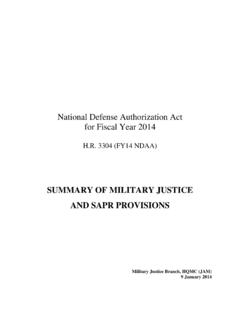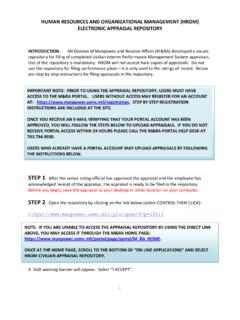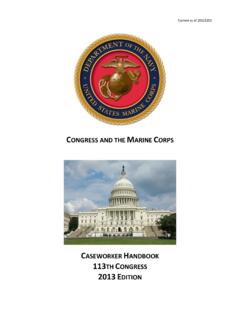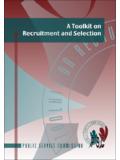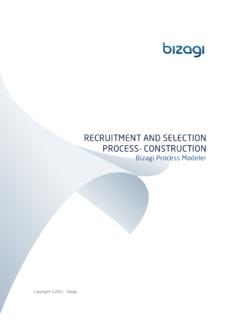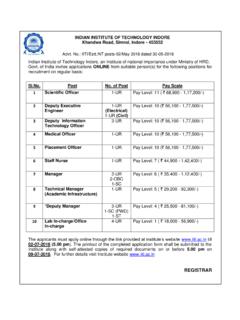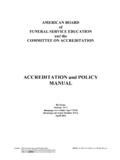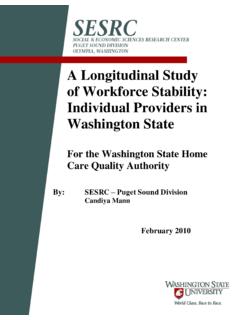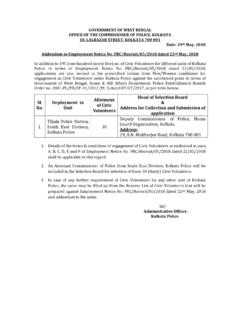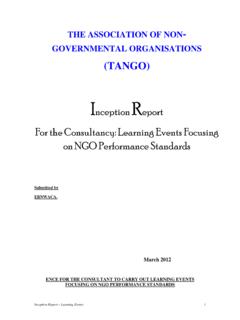Transcription of HQMC Mentoring Guide
1 HQMC Mentoring Guide Director, Marine Corps Staff Administration and Resource Management Division Human Resources and Organizational Management (HROM) 703-604-4637/4666/2755 smb hqmc arhb HQMC Mentoring Guide Table of Contents Introduction 3 Roles and Responsibilities 4 Selecting a Mentor or Mentee 7 The Mentoring Process 9 Building a Productive Mentoring Relationship 11 Appendices A Mentoring Agreement
2 18 B Individual Leadership Development Plan 19 C Evaluation Forms 24 2 HQMC Mentoring Guide Introduction Mentoring is a relationship in which a more experienced person (the mentor) provides guidance, knowledge-sharing, and learning opportunities to a less experienced employee (the mentee). It is an effective way to provide professional development and to enhance learning between colleagues at different levels and stages of their career. A Mentoring program can benefit an organization in a number of ways, including the following.
3 Cost-effective professional and leadership development Opportunity to display and improve leadership abilities Improved recruitment and retention of a talented and diverse workforce Increased organizational communication and understanding Improved succession planning Increased employee motivation Increased management ownership and engagement In a formal Mentoring relationship such as the Marine Corps Civilian Leadership Development Program (CLDP), mentors and mentees are sometimes matched by a third party, taking into account certain characteristics and common goals.
4 The relationship is then monitored and guided by specific roles, responsibilities and schedules. In an informal Mentoring relationship the mentor and the mentee are not matched by the third party but rather select each other informally. The Mentoring relationship is not structured, as compared with the formal program. In either case, the success of a mentor relationship is based on the understanding of the expectations agreed upon by each member at the first meeting (see Appendix A) and the follow through of both parties. The resources provided here are meant to serve as a Guide for establishing the groundwork of the relationship and can be tailored to meet your individual needs.
5 3 HQMC Mentoring Guide Roles and Responsibilities Mentor's Responsibilities Assist employee in setting realistic career and developmental goals and in creating an individual development plan (IDP) as part of the Mentoring program (See Appendix B for IDP format) Share their professional experiences and knowledge Provide information that will assist the mentee in learning about the culture and values of the organization. Provide constructive feedback to the employee about perceived strengths and developmental needs Point out opportunities for the employee to develop and demonstrate capabilities, as well as pitfalls to avoid Coach the employee on effective problem-solving techniques and leadership skills.
6 Encourage, motivate, and build the employee s sense of self and level of self-confidence Help the employee to expand his or her personal network and help arrange special assignments, shadowing experiences, etc. Teach by example and serve as an unbiased coach, confidant, and advisor. Maintain confidentiality Benefits Information gathering -- a great source of organizational data, feedback, and fresh ideas Personal satisfaction -- an opportunity to make a difference and leave a meaningful legacy Sharpened leadership and interpersonal skills Source of recognition Expanded professional contacts 4 HQMC Mentoring Guide Roles and Responsibilities Mentee's Responsibilities Actively demonstrate initiative and desire to learn Objectively assess developmental needs, establish clear developmental goals.
7 And communicate openly about them Take responsibility for personal growth and development Take the initiative to schedule meetings and to seek the mentor's advice Be receptive to feedback and coaching Maintain a positive and constructive attitude Take advantage of training, developmental activities, and assistance offered Maintain confidentiality Benefits Expanded support network Accelerated professional and leadership development Greater awareness of career and personal capabilities and possibilities Opportunities to demonstrate capabilities Greater visibility in the organization Targeted development activities Enhanced self-esteem, confidence.
8 And likelihood of success Increased understanding of the organization and what is needed to succeed and advance 5 HQMC Mentoring Guide Roles and Responsibilities Supervisor's Responsibilities Encourage employees to participate in the Mentoring program Allow reasonable time for Mentoring activities Provide candid feedback about the employee's strengths and developmental needs as it relates to the Mentoring program goals Continue to manage employee's job performance and development; Mentoring programs do not take the place of the supervisor's performance management responsibilities Respect the confidentiality of the Mentoring relationship; do not seek information from the mentor Support the Mentoring program.
9 Consider becoming a mentor to someone else Benefits Motivated and engaged employees Improved skills on the job Funding source for needed training (in formal programs such as CLDP) Commitment to employees builds commitment to the organization Satisfaction of helping develop Marine Corps future leaders 6 HQMC Mentoring Guide Selecting a Mentor or Mentee The mentee should meet with a number of potential mentors before selecting their mentor. Keep in mind the mentor should be two grades above the employee and outside the employee's chain of command. Make a list of potential mentors from those you know and admire or from those recommended by your supervisor, your manager, and/or your Mentoring program coordinator.
10 Before you meet with potential mentors, make sure you know what you want from the relationship, what your career goals are, what knowledge and skills you want to enhance, and what communication styles are best for you. Then schedule a meeting with each one to share your goals and get to know one another better. Below are some questions to consider as you select your mentor: What are your career goals and needs? Does the mentor have knowledge and experience in related areas? Is the mentor good at what he/she does? Is the mentor a good role model? How does the organization judge the mentor?

